 This beta release of the 1541-III firmware holds lot’s and lot’s of new features. But the most important feature of it all also makes it the most useable version of all 1541-III firmware releases. Why, because it supports JiffyDos. JiffyDos consists of a fastloader that makes all disk acces much and much faster. Making the use of your precious commodore much more fun.
This beta release of the 1541-III firmware holds lot’s and lot’s of new features. But the most important feature of it all also makes it the most useable version of all 1541-III firmware releases. Why, because it supports JiffyDos. JiffyDos consists of a fastloader that makes all disk acces much and much faster. Making the use of your precious commodore much more fun.
For those who are not familiar with the JiffyDos, just google, otherwise, thrust me. It’s really usefull. JiffyDos speeds up ALL your diskacces. Programs or games without a fastloader used to be slow… but suddenly they become as fast as… “greased lightning!!!”. So enough about JiffyDos.
Why is this release a beta release, simply because this release holds a lot of changes made to the 1541-III’s firmware, very crucial changes. Most changes are not noticed by the user, and some are never used. But I won’t go into detail.
This release is usefull for those who want to test JiffyDos on the 1541-III. And it needs to be tested. Because it will contain bugs, therefore we need to have it tested by YOU, so YOU can make a list of programs/files that works/fails. If you can supply it with a decent description it helps us in developing/fixing the bugs. Making it into a stable release.
source: jderogee.tripod.com
 SCA – streamed char animation – is an animation (image sequence) with the dimension of 200×160 pixels, converted into the C64 charsets (25×20 chars).
SCA – streamed char animation – is an animation (image sequence) with the dimension of 200×160 pixels, converted into the C64 charsets (25×20 chars).
One frame includes two multicolor charsets, the whole animation uses one static video and color RAM. SCA Converter utility (application) creates this kind of animation on Windows platforms.
application screenshot:
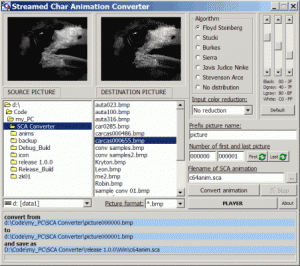
source: ide64.org
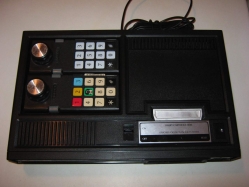
autopsy:
Cartridges list:
- Cosmic Avenger by Universal.
- Gorf by Midway.
- Donkey Kong by Nintendo.
- Mr.Do by Universal.
from Wikipedia:
The ColecoVision is Coleco Industries’ second generation home video game console which was released in August 1982. The ColecoVision offered arcade-quality graphics and gaming style, the ability to play Atari 2600 video games, and the means to expand the system’s basic hardware.
Released with a catalog of twelve launch titles, with an additional ten games announced for 1982, approximately 125 titles in total were published as ROM cartridges for the system between 1982 and 1984.
source: wikipedia
 SD2IEC is a hardware mass storage device using an SD/MMC card and interfacing with the IEC bus. It is based on the ATmega644 microcontroller from the Atmel AVR microcontroller family. The most prominent use of SD2IEC is emulation/replacement of a Commodore-1541 disk drive for a C64.
SD2IEC is a hardware mass storage device using an SD/MMC card and interfacing with the IEC bus. It is based on the ATmega644 microcontroller from the Atmel AVR microcontroller family. The most prominent use of SD2IEC is emulation/replacement of a Commodore-1541 disk drive for a C64.
Hardware and the microcontroller’s firmware is available as open source (GPL).
Changelog:
2009-05-24 – release 0.8.1a
- Fix bootloader version number generation.
source: sd2iec.de gitweb forum thread c64-wiki

GoatTracker is a cross-platform tracker written by Lasse Öörni, producing SID chiptune music for the Commodore 64, and released with source code under the GPL. It is notable for being possibly the only SID chiptune-composer NOT native to the C64, as many alternative composers (including JCH, and CyberTracker) only execute on the C64 or inside C64 emulators.
Many SID tunes are available in various formats on the Internet, especially through the High Voltage SID Collection (HVSC). GoatTracker is capable of directly exporting to the .sid (PSID/RSID) file format in addition to standard C64 PRG files.
This Mac OS X port of GoatTracker integrates the cross-platform code with a standard Mac OS X GUI, and adds additional features, such as MIDI keyboard support and comprehensive built-in help.
Screenshot:
source:
www.sidmusic.org/goattracker/mac/
 SID Duzz it, it’s a SID Music Editor by Geir Tjelta of SHAPE.
SID Duzz it, it’s a SID Music Editor by Geir Tjelta of SHAPE.
source: noname.c64.org
 SD2IEC is a hardware mass storage device using an SD/MMC card and interfacing with the IEC bus. It is based on the ATmega644 microcontroller from the Atmel AVR microcontroller family. The most prominent use of SD2IEC is emulation/replacement of a Commodore-1541 disk drive for a C64.
SD2IEC is a hardware mass storage device using an SD/MMC card and interfacing with the IEC bus. It is based on the ATmega644 microcontroller from the Atmel AVR microcontroller family. The most prominent use of SD2IEC is emulation/replacement of a Commodore-1541 disk drive for a C64.
Hardware and the microcontroller’s firmware is available as open source (GPL).
Changelog:
2009-05-20 – release 0.8.1
- Fix uIEC/IDE SD card change detection.
- Dreamload support for uIEC.
- Mark the RTC time as valid after setting the clock.
- Delay SPI initialisation until absolutely required.
- Show disk change confirmation even when the error blink is active.
- Exit the FC3 fastloader if ATN is active.
- Fix indentation of 1000+ block files.
- Remove 0-byte from the long version message.
- Fix multiple save-with-replace bugs.
- Ignore directories when matching file name wildcards.
source: sd2iec.de gitweb forum thread c64-wiki
 ACID 64 Player Pro is the sequal of Acid 64 Player and is a cycle based Commodore 64 music player designed for playing SID tunes on sound cards/devices that have a real SID chip (6581/6582/8580) on board like the HardSID cards and HardSID 4U USB device.
ACID 64 Player Pro is the sequal of Acid 64 Player and is a cycle based Commodore 64 music player designed for playing SID tunes on sound cards/devices that have a real SID chip (6581/6582/8580) on board like the HardSID cards and HardSID 4U USB device.
ACID 64 emulates the MOS 6510 micro processor, the 6526 CIA chip and partially the 6569 VIC chip to run the code of a SID tune and it controls the SID chip on the device for playing the Commodore 64 music.
What’s new in version 3.0.1
Fixes
- On some machines the index file wasn’t created correctly (re-indexing is required)
- Indexing of folder with a few SIDs is fixed
- Seek speed isn’t dependent anymore on fast forward limitation
- STIL and SLDB info are now working for files outside HVSC
- Minimal horizontal width isn’t locked to previous width anymore
Improvements
- STIL window can always be opened now and doesn’t close automatically anymore
- Improved handling of SLDB entries
- Digital clock color changed
- Changed a few keyboard short cuts
- A few other small improvements/fixes
screenshot:
source: acid64.com
 This is a game programming competition, not a game playing competition.
This is a game programming competition, not a game playing competition.
The idea of this competition is to write a new game for the MiniGame compo.
source: minigamecomp.org.uk
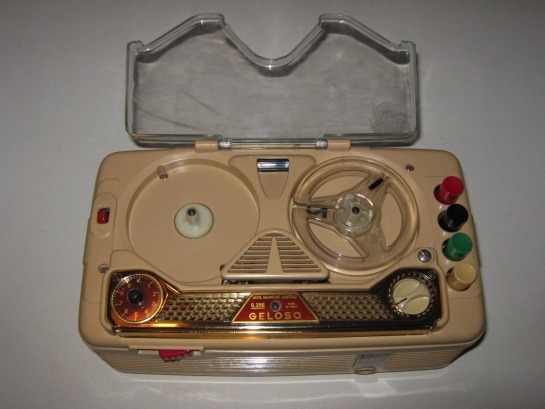
autopsy:
This great Tape Recorder it was donated from my Father.
from Wikipedia:
Geloso, founded in 1931 by John Geloso, was an Italian manufacturer of radios, televisions, amplifiers, amateur receivers, audio equipment and component electronics, that had headquarters in Milan, Viale Brenta 29. In 1931 they began to produce not only Radio but also, by choice of John Geloso same, most of the electronic components with which they were built, and over time developing and patenting also many others.
source: radiopistoia.com wikipedia
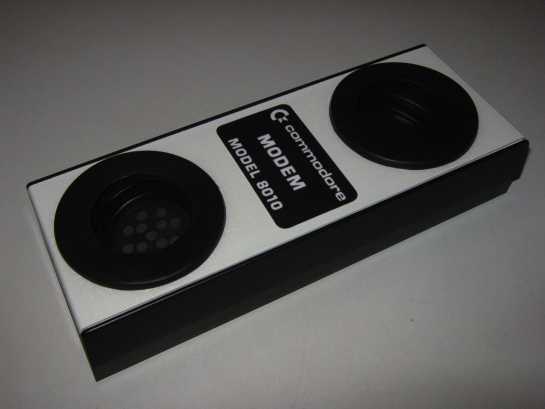
autopsy:
This is my first Modem, this is a Acoustic coupler modem for Commodore PET but i could use it with a IEEE488 Interface for the Commodore 64.
The Commodore’s 8010 Modem is an IEEE-488 (1978 standard) device which communicates via any standard telephone.
The 8010 Modem meets Bell 103 standards for communication at a fixed rate of 00 BAUD. The telephone interface is acoustic so the modem is portable. This means Commodore computers can communicate with, large computer systems like The Source and MICRONET, and other small computers.
Initially Commodore supplied software will support the following applications, with many more to come.
1) Terminal emulation.
2) Disk file send and receive.
3) Wordpro 3 sequential file send.
4) Hardcopy using Commodore printers.
5) Disk spooling.
A switchable four-section bandpass filter provides out-of-band rejection assuring accurate processing of the input from received carrier, even at signal levels of less than -47 dBm.
Jitter-free data is guaranteed by a soft limiter and phase lock loop discriminator. The carrier detect circuitry prevents the CBM Modem from operating when excessive noise would produce errors or cause marginal operation. This feature also assures accurate teleprocessing connections and inhibits chatter when the received signal fades.
 ACID 64 Player Pro is the sequal of Acid 64 Player and is a cycle based Commodore 64 music player designed for playing SID tunes on sound cards/devices that have a real SID chip (6581/6582/8580) on board like the HardSID cards and HardSID 4U USB device.
ACID 64 Player Pro is the sequal of Acid 64 Player and is a cycle based Commodore 64 music player designed for playing SID tunes on sound cards/devices that have a real SID chip (6581/6582/8580) on board like the HardSID cards and HardSID 4U USB device.
ACID 64 emulates the MOS 6510 micro processor, the 6526 CIA chip and partially the 6569 VIC chip to run the code of a SID tune and it controls the SID chip on the device for playing the Commodore 64 music.
What’s new in version 3.0.0
New:
- Fast incremental SID file search on title, author, year and publisher fields
- Seek through SID tunes via slider bar
- Digital clock
- Scroll wheel support when hovering over grids and list boxes
- Anonymous usage statistics
Improvements:
- Tree view of folders
- SidID search in properties menu is done in background now to access dialog faster
- Emulation improvements
- Keyboard navigation improvements
- Many small improvements/fixes
screenshot:
source: acid64.com
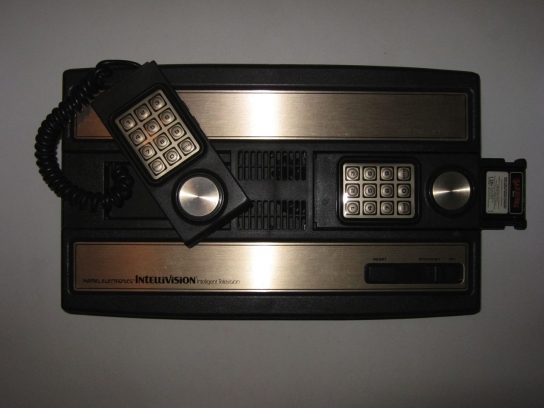
Autopsy:
from Wikipedia homepage:
 The Intellivision was developed by Mattel Electronics, a subsidiary of Mattel formed expressly for the development of electronic games.
The Intellivision was developed by Mattel Electronics, a subsidiary of Mattel formed expressly for the development of electronic games.
The console was test marketed in Fresno, California, in 1979 with a total of four games available, and was released nationwide in 1980 with a price tag of US$299 and a pack-in game: Las Vegas Poker & Blackjack. Though not the first system to challenge Atari, it was the first to pose a serious threat to Atari’s dominance.
A series of ads featuring George Plimpton was produced that mercilessly attacked the Atari 2600′s lesser capabilities with side-by-side game comparisons.
source: wikipedia
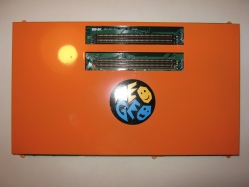
Autopsy:
from Wikipedia:
The Neo Geo is a cartridge-based arcade and home video game system released in 1990 by Japanese game company SNK. The system offered comparatively colorful 2D graphics and high-quality sound.
A major platform for arcade games at the time, the system was also available as a costly home console. The two versions of the system were known as the AES (Advanced Entertainment System, the home version) and the MVS (Multi Video System, the arcade version).
The Neo Geo was marketed as 24-bit, though it was technically an 8/16/32-bit multiprocessing system.
source: wikipedia
 This beta release of the 1541-III firmware holds lot’s and lot’s of new features. But the most important feature of it all also makes it the most useable version of all 1541-III firmware releases. Why, because it supports JiffyDos. JiffyDos consists of a fastloader that makes all disk acces much and much faster. Making the use of your precious commodore much more fun.
This beta release of the 1541-III firmware holds lot’s and lot’s of new features. But the most important feature of it all also makes it the most useable version of all 1541-III firmware releases. Why, because it supports JiffyDos. JiffyDos consists of a fastloader that makes all disk acces much and much faster. Making the use of your precious commodore much more fun. SCA – streamed char animation – is an animation (image sequence) with the dimension of 200×160 pixels, converted into the C64 charsets (25×20 chars).
SCA – streamed char animation – is an animation (image sequence) with the dimension of 200×160 pixels, converted into the C64 charsets (25×20 chars).


















 ACID 64 Player Pro is the sequal of Acid 64 Player and is a cycle based Commodore 64 music player designed for playing SID tunes on sound cards/devices that have a real SID chip (6581/6582/8580) on board like the HardSID cards and HardSID 4U USB device.
ACID 64 Player Pro is the sequal of Acid 64 Player and is a cycle based Commodore 64 music player designed for playing SID tunes on sound cards/devices that have a real SID chip (6581/6582/8580) on board like the HardSID cards and HardSID 4U USB device.
 This is a game programming competition, not a game playing competition.
This is a game programming competition, not a game playing competition.






















































 The Intellivision was developed by Mattel Electronics, a subsidiary of Mattel formed expressly for the development of electronic games.
The Intellivision was developed by Mattel Electronics, a subsidiary of Mattel formed expressly for the development of electronic games.


















Recent Comments